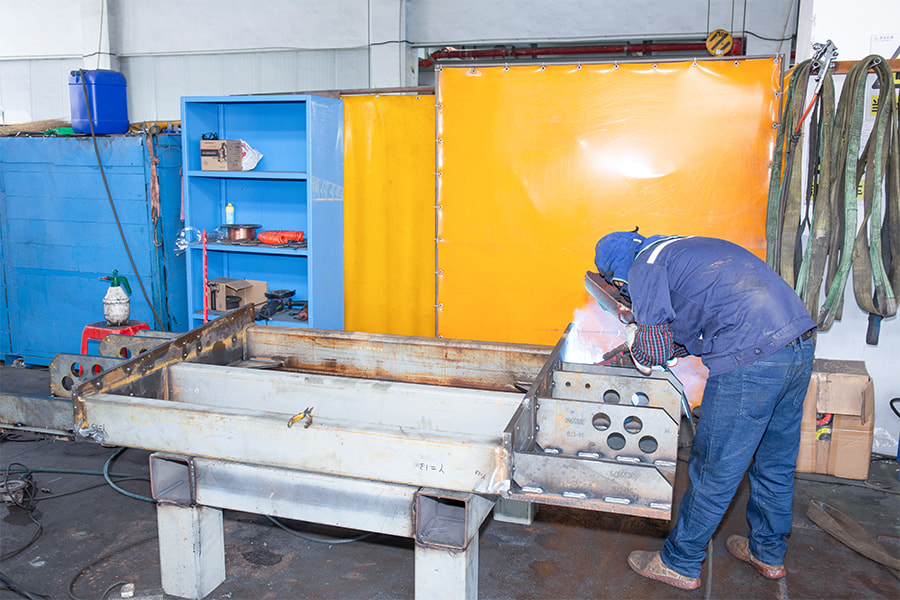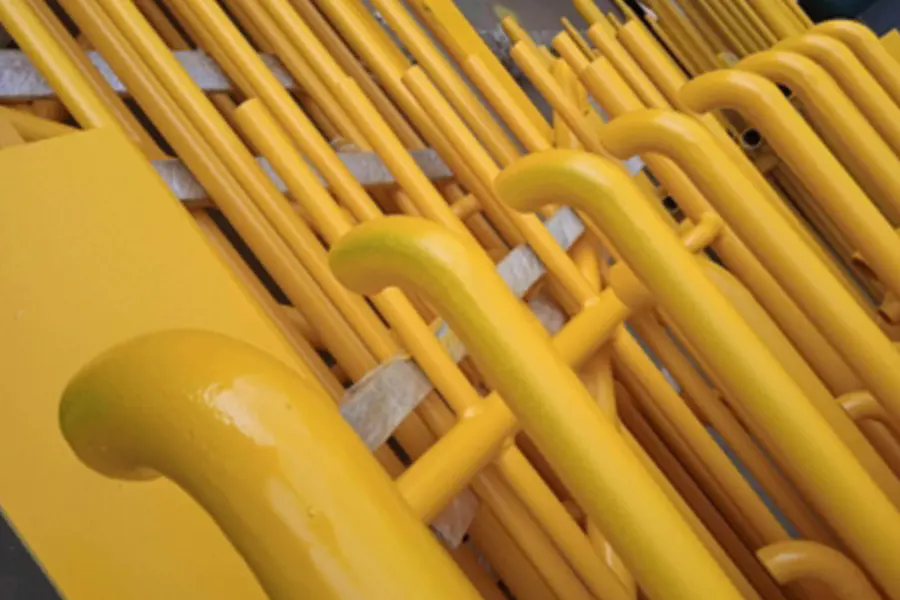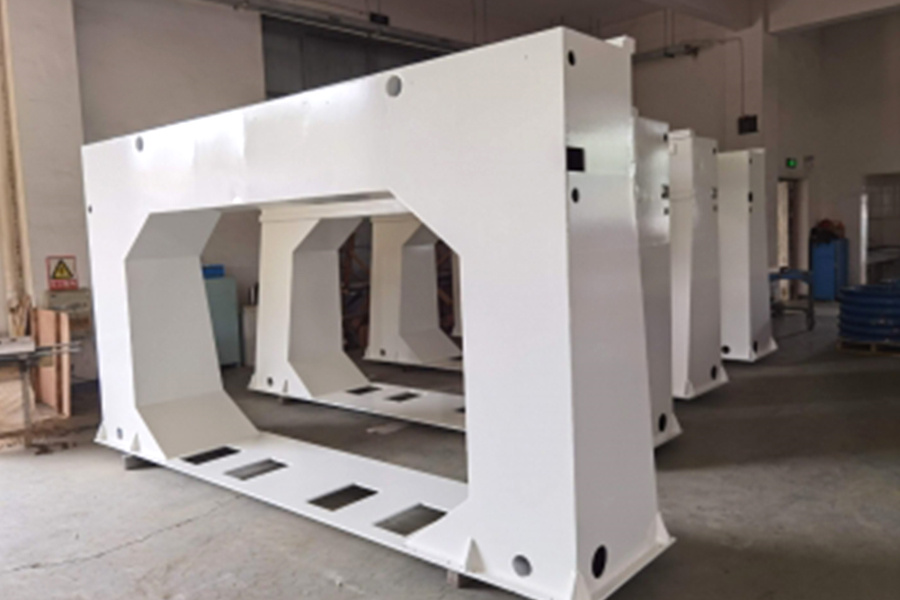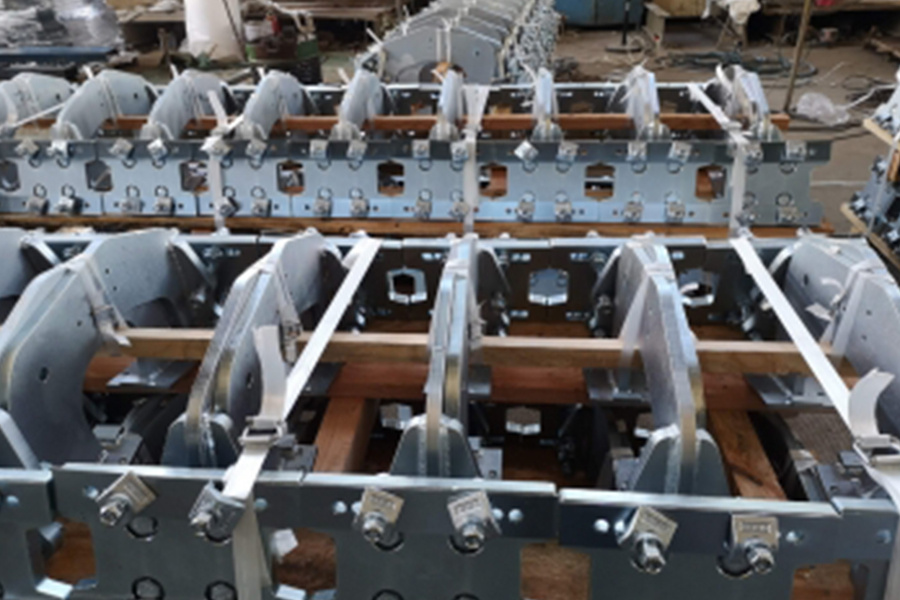No.158, Baoqun Road, Yaozhuang Town, Jiashan County, Jiaxing City, Zhejiang Province , China

Industrial and manufacturing equipment structures must be designed to withstand heavy loads, dynamic forces, and harsh environmental conditions. These structures include steel structural components for machinery, industrial equipment support frames, and heavy-duty steel frames for manufacturing, all of which require careful engineering to ensure durability and operational efficiency.
One of the primary considerations is load-bearing capacity. Equipment such as CNC machine steel frame components and structural steel parts for industrial machines must support not only the weight of the machinery but also vibrations, impacts, and thermal expansions. Engineers must analyze static and dynamic loads to prevent deformation or failure over time.
Material selection is another critical factor. High-strength steel alloys are commonly used in custom steel fabrication for equipment due to their resilience and weldability. The choice between carbon steel, alloy steel, or stainless steel depends on factors like corrosion resistance, fatigue life, and cost efficiency.
Modularity is increasingly important in modern manufacturing. Modular steel structures for equipment allow for easy reconfiguration, reducing downtime during facility upgrades. Similarly, industrial skid base fabrication enables the relocation of entire machinery setups without disassembly, improving operational flexibility.
Environmental factors such as temperature fluctuations, humidity, and chemical exposure must also be considered. Protective coatings, galvanization, and proper ventilation can mitigate corrosion risks in structural steel brackets for equipment and welded assemblies for industrial use.
Finally, compliance with industry standards (such as OSHA, ISO, and ASME) ensures that steel platforms for heavy equipment and other structures meet safety and performance benchmarks. Finite element analysis (FEA) and computer-aided design (CAD) are often employed to simulate stress distribution and optimize structural integrity.
The selection of steel for structural components for heavy equipment depends on mechanical properties, environmental conditions, and fabrication requirements. The most commonly used steels in Industrial Equipment Manufacturing include carbon steel, alloy steel, and stainless steel, each offering distinct advantages.
Carbon steel is widely used in fabricated steel support frames due to its high strength and affordability. Low-carbon steel (A36) is suitable for equipment base frame steel, while high-carbon steel provides greater hardness for wear-resistant components.
Alloy steels, such as 4140 or 4340, are preferred for automation equipment steel frames because of their enhanced toughness and fatigue resistance. Chromium, molybdenum, and nickel additives improve heat treatment response, making these alloys ideal for high-stress applications.
Stainless steel (e.g., 304 or 316) is essential in corrosive environments. Structural steel frames for processing equipment in chemical or food industries often use stainless steel to prevent rust and contamination.
Tool steels (D2, H13) are employed in high-wear applications, such as heavy equipment steel support structures, where hardness and abrasion resistance are crucial. Weathering steel (Corten) is another option for outdoor installations, forming a protective oxide layer that eliminates the need for paint.
The choice of steel must align with fabrication methods. Welded assemblies for industrial use require materials with good weldability, while machined components may prioritize machinability ratings. Proper heat treatment and surface finishing further enhance performance and longevity.
The installation of large steel structural components is a critical process in Industrial Equipment Manufacturing, requiring meticulous planning, precise execution, and strict adherence to safety protocols. These components, including industrial equipment support frames, heavy-duty steel frames for manufacturing, and structural steel parts for industrial machines, form the backbone of many industrial operations. Proper installation ensures structural integrity, operational efficiency, and long-term reliability.
Before any physical work begins, a thorough assessment of the installation site and the steel structural components for machinery is essential. This phase involves reviewing engineering drawings, load-bearing requirements, and environmental conditions. The custom steel fabrication for equipment must align with the intended application, whether for CNC machine steel frame components or modular steel structures for equipment.
A site survey should verify foundation readiness, ensuring that anchor points for equipment base frame steel are correctly positioned. Additionally, the weight and dimensions of heavy equipment steel support structures must be evaluated to determine the appropriate lifting and rigging equipment. Safety hazards, such as overhead obstructions or uneven terrain, should be identified and mitigated.
Large structural steel frames for processing equipment require specialized handling to prevent damage and ensure worker safety. Cranes, forklifts, and other lifting devices must be rated for the load capacity of welded assemblies for industrial use. Rigging hardware, such as slings and shackles, should be inspected for wear and tear before use.
Transportation logistics must account for the size and weight of fabricated steel support frames, ensuring that delivery routes are clear and storage areas are prepared. Components like steel platforms for heavy equipment should be stored on level surfaces to prevent warping or misalignment before installation.
Once on-site, the assembly process begins with positioning the structural steel brackets for equipment according to the design specifications. Temporary supports may be used to hold components in place before permanent fastening. Bolted or welded connections must follow industry standards to ensure stability.
Alignment is critical, particularly for automation equipment steel frames, where precision affects operational performance. Laser levels, theodolites, or other measuring tools should be used to verify that structural components for heavy equipment are level, plumb, and correctly spaced. Any deviations must be corrected before proceeding.
After alignment, permanent fastening methods are applied. High-strength bolts, welding, or a combination of both may be used to secure industrial skid base fabrication and other large assemblies. Welding procedures must comply with industry codes to avoid weak joints or material distortion.
For added stability, secondary reinforcements such as gussets or cross-bracing may be installed on heavy-duty steel frames for manufacturing. These enhancements improve load distribution and resistance to dynamic forces, such as vibrations from machinery.
A comprehensive inspection is necessary to confirm that all steel structural components meet safety and performance standards. Key checks include:
Load testing may be conducted on steel platforms for heavy equipment to validate their capacity under operational conditions. Any issues identified during testing must be addressed before the structure is put into service.
Even after installation, regular maintenance is crucial to prolong the lifespan of structural steel parts for industrial machines. Routine inspections should assess for signs of fatigue, corrosion, or loosened connections. Protective coatings may be reapplied to prevent rust, especially in harsh industrial environments.
Workers involved in maintenance must follow safety protocols, including the use of personal protective equipment (PPE) and lockout/tagout procedures when servicing structural steel frames for processing equipment.
The safe installation of large steel structural components in industrial facilities demands careful planning, precise execution, and rigorous quality control. From custom steel fabrication for equipment to final load testing, each step plays a vital role in ensuring structural reliability and operational safety. By adhering to best practices in handling, assembly, and maintenance, industrial facilities can maximize the performance and durability of their industrial equipment support frames and related structures.
| Phase | Key Actions |
|---|---|
| Pre-Installation | Review designs, assess site conditions, verify foundation readiness. |
| Handling & Transport | Use appropriate lifting equipment, inspect rigging, ensure safe storage. |
| Assembly & Alignment | Position components accurately, use temporary supports, verify alignment. |
| Securing & Reinforcing | Apply proper bolting/welding techniques, install reinforcements if needed. |
| Inspection & Testing | Check weld/bolt integrity, conduct load tests, address defects. |
| Maintenance | Schedule routine inspections, apply protective coatings, follow safety protocols. |
By following these structured steps, industrial facilities can ensure the safe and efficient installation of critical steel structural components, supporting long-term operational success.
Steel structural components are fundamental to industrial and manufacturing equipment structures, providing durability, strength, and stability. Whether used in industrial equipment support frames, heavy-duty steel frames for manufacturing, or CNC machine steel frame components, these elements must be maintained properly to ensure long-term performance. Given the demanding environments in which they operate—exposure to heavy loads, vibrations, and corrosive agents—proactive maintenance is essential.
Routine inspections are critical for identifying early signs of wear, corrosion, or structural fatigue in structural steel parts for industrial machines. Visual inspections should focus on weld integrity, surface degradation, and alignment accuracy. Advanced techniques, such as ultrasonic testing or magnetic particle inspection, can detect subsurface flaws that may compromise performance.
For modular steel structures for equipment, inspections should verify bolt tightness, joint stability, and load-bearing capacity. Industrial skid base fabrication and steel platforms for heavy equipment often experience stress concentrations, making frequent assessments necessary to prevent unexpected failures.
Corrosion is a leading cause of degradation in fabricated steel support frames and structural steel brackets for equipment. Protective coatings, such as galvanization, epoxy paints, or powder coatings, create barriers against moisture and chemicals. In harsh environments, stainless steel or weathering-resistant alloys may be preferred for equipment base frame steel components.
Regular cleaning to remove dirt, grease, and chemical residues helps preserve coatings. For welded assemblies for industrial use, crevice corrosion can develop in joints, necessitating sealants or corrosion inhibitors. Cathodic protection systems may also be employed for submerged or buried steel structures.
Moving parts within automation equipment steel frames or structural components for heavy equipment require proper lubrication to minimize friction and wear. Bearings, hinges, and sliding mechanisms should be serviced according to manufacturer specifications. Over-lubrication can attract contaminants, while under-lubrication accelerates component degradation.
For structural steel frames for processing equipment, vibration-induced wear can loosen fasteners and connections. Anti-vibration pads, lock washers, and thread-locking compounds help maintain stability.
Overloading heavy equipment steel support structures leads to premature fatigue and deformation. Engineers must ensure that operational loads remain within design limits. Reinforcement strategies, such as adding gussets or braces, may be necessary if usage conditions change.
Custom steel fabrication for equipment should account for dynamic loads, shock impacts, and thermal expansion. Periodic reassessment of load distribution helps prevent stress concentrations in industrial equipment manufacturing applications.
When damage is detected, timely repairs prevent further deterioration. Cracked welds in welded assemblies for industrial use should be ground out and re-welded to restore integrity. Bent or distorted steel platforms for heavy equipment may require straightening or partial replacement.
For severely corroded or fatigued structural steel parts for industrial machines, replacement is often more cost-effective than repeated repairs. Using higher-grade materials or improved fabrication techniques in replacements can enhance longevity.
Effective maintenance of steel structural components—whether in industrial equipment support frames, CNC machine steel frame components, or heavy-duty steel frames for manufacturing—requires a systematic approach. Regular inspections, corrosion protection, lubrication, load management, and prompt repairs collectively extend service life while minimizing downtime. By implementing these practices, industries can ensure the reliability and durability of their critical steel structures.
| Practice | Application Example | Benefit |
|---|---|---|
| Regular Inspections | Industrial skid base fabrication | Early detection of cracks and corrosion |
| Corrosion Protection | Structural steel brackets for equipment | Prevents material degradation |
| Lubrication Management | Automation equipment steel frames | Reduces friction and wear |
| Load Monitoring | Heavy equipment steel support structures | Prevents overloading and deformation |
| Timely Repairs | Welded assemblies for industrial use | Restores structural integrity |
Adhering to these principles ensures that steel structural components remain operational under demanding industrial conditions, safeguarding both performance and safety.
Steel structures are fundamental to industrial and manufacturing operations, providing the necessary support and durability for heavy machinery, processing equipment, and automation systems. Over time, however, steel structural components for machinery are subjected to cyclic loading, vibrations, and environmental factors that can lead to fatigue and stress cracks. Detecting these issues early is critical to preventing catastrophic failures, ensuring operational safety, and maintaining the longevity of industrial equipment support frames.
Fatigue cracks develop due to repeated stress cycles, even when the applied loads are well below the material’s yield strength. These cracks often initiate at stress concentration points, such as weld joints, bolt holes, or sharp corners in structural steel parts for industrial machines. Stress cracks, on the other hand, may result from overloading, improper fabrication, or material defects. Both types of cracks can propagate over time, compromising the integrity of heavy-duty steel frames for manufacturing and other critical structures.
Industrial equipment manufacturing relies heavily on fabricated steel support frames, which must be routinely inspected to detect early signs of degradation. Common areas of concern include welded assemblies for industrial use, modular steel structures for equipment, and structural steel brackets for equipment, where stress concentrations are most likely to occur.
Visual inspection is the most basic yet essential method for identifying surface-level cracks, corrosion, or deformations in steel platforms for heavy equipment. Inspectors should examine:
For CNC machine steel frame components and automation equipment steel frames, a magnifying glass or borescope can help detect fine cracks that are not visible to the naked eye. Dye penetrant testing (DPT) is another non-destructive method where a colored dye is applied to the surface, seeping into cracks and revealing their presence under UV light.
When visual inspection is insufficient, advanced NDT techniques provide deeper insights into the condition of structural steel frames for processing equipment. Common methods include:
MPI is effective for detecting surface and near-surface cracks in ferromagnetic materials. A magnetic field is applied to the steel, and iron particles are dispersed over the surface. Any discontinuities, such as cracks, will disrupt the magnetic field, causing the particles to cluster at the defect site. This method is particularly useful for inspecting industrial skid base fabrication and equipment base frame steel.
UT uses high-frequency sound waves to identify internal flaws. A transducer sends ultrasonic pulses through the material, and reflections from cracks or voids are analyzed. This technique is ideal for thick-walled steel structures, such as heavy equipment steel support structures, where internal defects may not be visible externally.
RT involves X-rays or gamma rays to capture images of a structure’s internal composition. It is highly effective for assessing welded assemblies for industrial use, revealing porosity, slag inclusions, or incomplete penetration in welds. However, due to safety concerns, RT requires specialized training and controlled environments.
ECT is used for detecting surface and subsurface cracks in conductive materials. An alternating current induces eddy currents in the steel, and disruptions caused by cracks alter the current flow, which is measured by a probe. This method is suitable for inspecting structural components for heavy equipment with complex geometries.
While inspections are crucial, preventive measures can significantly reduce the risk of fatigue and stress cracks in custom steel fabrication for equipment. Key strategies include:
Inspecting steel structural components for machinery and industrial equipment support frames for fatigue and stress cracks is a critical aspect of industrial maintenance. Utilizing a combination of visual inspections and advanced NDT methods ensures that potential failures are identified before they escalate. By implementing robust inspection protocols and preventive measures, industries can maintain the reliability and safety of heavy-duty steel frames for manufacturing, CNC machine steel frame components, and other critical structures. Proactive maintenance not only extends the lifespan of these components but also enhances operational efficiency and workplace safety.
| Inspection Method | Best For | Limitations |
|---|---|---|
| Visual Inspection | Surface cracks, weld defects | Limited to visible areas |
| Magnetic Particle Inspection | Surface and near-surface cracks | Only for ferromagnetic materials |
| Ultrasonic Testing | Internal flaws, thick sections | Requires skilled operators |
| Radiographic Testing | Weld integrity, internal defects | Radiation safety concerns |
| Eddy Current Testing | Conductive materials, fine cracks | Limited penetration depth |
By integrating these techniques into a structured inspection regime, industries can safeguard their steel structures against fatigue and stress-related failures, ensuring long-term operational stability.
Industrial steel structures form the backbone of manufacturing and processing facilities, providing essential support for heavy-duty equipment, machinery, and operational platforms. Over time, factors such as corrosion, fatigue, and dynamic loads can compromise the integrity of these structures. Reinforcing aging steel structural components is critical to ensuring safety, extending service life, and maintaining operational efficiency.
Before implementing reinforcement strategies, a thorough assessment of the existing steel structural components for machinery is necessary. Visual inspections, non-destructive testing (NDT), and structural analysis help identify weak points such as cracks, corrosion, or deformation. Common areas requiring reinforcement include heavy-duty steel frames for manufacturing, structural steel parts for industrial machines, and welded assemblies for industrial use.
Key inspection techniques include:
A detailed assessment ensures that reinforcement efforts are targeted and cost-effective.
One of the most direct methods for reinforcing aging steel structures is adding supplementary steel plates or sections. This technique is commonly applied to CNC machine steel frame components, fabricated steel support frames, and structural steel frames for processing equipment.
This method is particularly effective for modular steel structures for equipment, where localized reinforcement is needed.
CFRP wrapping is a lightweight, high-strength alternative to traditional steel reinforcement. It is ideal for reinforcing steel platforms for heavy equipment and automation equipment steel frames where adding extra steel may be impractical.
For structures requiring additional lateral stability, bolted or riveted bracing systems can be installed. This method is frequently used in industrial equipment support frames and heavy equipment steel support structures.
This approach is beneficial when welding is not feasible due to fire hazards or material constraints.
Aging steel structures often suffer from foundation settlement or loose anchor bolts. Grout injection stabilizes the base of industrial skid base fabrication and steel platforms for heavy equipment by filling voids and restoring load distribution.
In cases where corrosion or fatigue damage is extensive, selective replacement of structural steel brackets for equipment or other critical elements may be necessary. Custom steel fabrication for equipment ensures that replacement parts match original specifications while incorporating improved materials or designs.
Choosing the right materials is crucial for long-term reinforcement success. Common options include:
| Material | Best Use Case |
|---|---|
| High-Strength Steel | Heavy-duty steel frames for manufacturing |
| Carbon Fiber (CFRP) | Automation equipment steel frames |
| Stainless Steel Cladding | Corrosion-prone welded assemblies for industrial use |
| Prefabricated Modular Steel | Modular steel structures for equipment |
Reinforcement efforts must be complemented with preventive measures to slow further degradation. Protective coatings, cathodic protection, and routine inspections are essential for maintaining structural steel parts for industrial machines.
Reinforcing aging industrial steel structures requires a combination of assessment, strategic reinforcement techniques, and preventive maintenance. Whether dealing with CNC machine steel frame components, heavy equipment steel support structures, or custom steel fabrication for equipment, the right approach ensures structural integrity and operational safety. By implementing methods such as steel plate bonding, CFRP wrapping, and grout injection, industrial facilities can prolong the lifespan of their steel structures while maintaining efficiency and reliability.

The steel structure industry has experienced significant evolution in recent years, d...
READ MORE
Optimizing the Engineering Workspace Boosting Comfort and Efficiency for Electrical...
READ MORE
The Structural Blueprint of Dimensioning Equipment Anatomy of the Planer-Thicknesser:...
READ MORE
The global shift towards sustainable power is undeniable, with new energy equipment l...
READ MORE